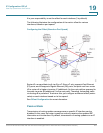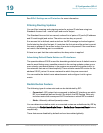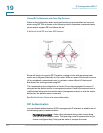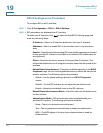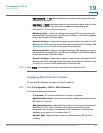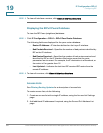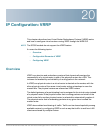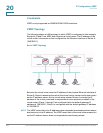
IP Configuration: RIPv2
Configuring RIP
388 Cisco Small Business 200, 300 and 500 Series Managed Switch Administration Guide (Internal Version)
19
RIPv2 Settings on an IP Interface
To configure RIP on an IP interface:
STEP 1 Click IP Configuration > RIPv2 > RIPv2 Settings.
STEP 2 RIP parameters are displayed per IP interface.
To add a new IP interface, click Add to open the Add RIPv2 Settings page and
enter the following fields:
• IP Address—Select an IP interface defined on the Layer 2 interface.
• Shutdown—Select to enable RIP on the interface even in the shutdown
state.
• Passive—Specifies whether sending RIP route update messages is allowed
on the specified IP interface. If this field is not enabled, RIP updates are not
sent (passive).
• Offset—Specifies the metric number of the specified IP interface. This
reflects the additional cost of using this interface, based on the speed of the
interface.
• Default Route Advertisement—This option is defined globally in the RIPv2
Properties page. You can use the global definition or define this field for the
specific interface. The following options are available:
- Global—Use the global settings defined in the RIPv2 Properties.
screen.
- Disable—On this RIP interface, do not advertise the default route.
- Enable—Advertise the default route on this RIP interface.
• Default Route Advertisement Metric—Enter the metric for the default route
for this interface.
• Authentication Mode—RIP authentication state (enable/disable) on a
specified IP interface. The following options are available:
- None—There is no authentication performed.
- Tex t—The key password entered below is used for authentication.
- MD5—The MD5 digest of the key chain selected below is used for
authentication.




